Charles Edwards, Barrister and TECBAR Adjudicator reviews a case which considers whether a party in adjudication should be allowed to prune their claim which forms part of a larger claim submitted to adjudication, in essence cherry picking that which they submit to adjudication from a larger claim? A recent case in the Technology and Construction Court enforcing an Adjudicator’s Decision provides useful guidance for parties in Adjudication: St Austell Printing Company Ltd v Dawnus Construction Holdings Ltd [2015] EWHC 96 (TCC).
Dawnus Construction Holdings Ltd (“Dawnus”) was seeking to enforce an Adjudicator’s decision and had issued a Part 7 claim, whereas St Austell Printing Company Ltd (“St A”), the party who lost the adjudication had issued pre-emptive Part 8 proceedings seeking a declaration that the Adjudicator did not have the jurisdiction to decide that £417,919.66 was due to Dawnus.
St A entered into a contract with Dawnus to carry out and complete the design and construction of two warehouse/industrial units in St Austell, Cornwall. The contract incorporated the JCT Design and Build Contract Form, 2005 edition. The Contract Administrator was Davis Langdon, now known as AECOM. Practical completion of the works was achieved on 6 February 2013 and on 26 April 2013, AECOM issued Interim Valuation 17 in the gross sum of just over £6,000,000.
On 10 December 2013, Dawnus issued an interim application for payment No.19 which included a significant amount of supporting documentation in the gross sum of almost £8,000,000. Dawnus’s application amounted to a net sum claimed of £2,300,000. This included a claim in respect of changes and variations of about £1,900,000, of which around £900,000 reflected the measured work element of those changes and variations. The due date for payment of Dawnus’s interim application was 4 January 2014.
On 17 December 2013, Dawnus mistakenly believed that AECOM had failed to serve a payment notice in due time and therefore sent a sales invoice in the sum of £2.3 million seeking payment by 4 January 2014.
On 19 December 2013, AECOM delivered to Dawnus Payment Notice No.18 which advised that the sum so far paid to Dawnus which was just over £6 Million by way of the valuation and payment made in April remained the correct valuation and that no further sum was due to Dawnus. AECOM also advised amongst other things that:
- They were currently reviewing Dawnus’s revised final account dated 10 December 2013;
- That during a site visit it was clear that a number of defects had not been addressed at this stage and that they would be writing to Dawnus formally detailing these outstanding defects;
- That AECOM would endeavour to send Dawnus their final version of the account early in the New Year and that they considered this to be reasonable following Dawnus’s recent response to the measured accounts;
- That with regards to Dawnus’s loss and expense claim, there had been a meeting with the client and his advisors to establish an accurate understanding of the events Dawnus had detailed within their claim document and that there was a further meeting to progress with these discussions arranged during week commencing 6 January 2014, following which a response would be sent separately to Dawnus with regards to the loss and expense, early in the New Year.
- The first jurisdictional challenge stated that no dispute about the changes had crystallised at the time of the Notice of Adjudication in August; and
- The second jurisdictional challenge stated that the Adjudicator had no power to order payment of part only of interim Application 19 in the Adjudication.
Charles Edwin Edwards MSt(Cantab) MSc(Lond) FCInstCES Barrister
NEW TEMPLE CHAMBERS
2nd Floor Berkeley Square House
Berkeley Square
Mayfair
London W1J 6BD
Tel: +44(0)207 887 6098





